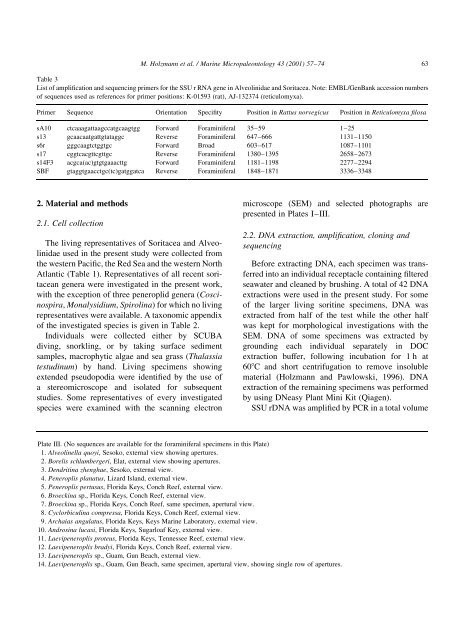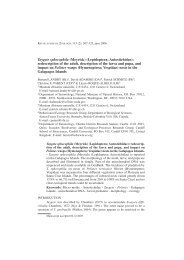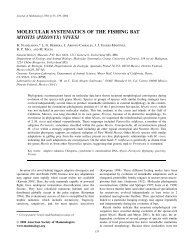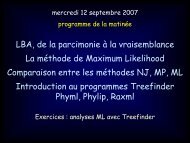Molecular phylogeny of large miliolid foraminifera - University of ...
Molecular phylogeny of large miliolid foraminifera - University of ...
Molecular phylogeny of large miliolid foraminifera - University of ...
You also want an ePaper? Increase the reach of your titles
YUMPU automatically turns print PDFs into web optimized ePapers that Google loves.
M. Holzmann et al. / Marine Micropaleontology 43 2001) 57±74 63Table 3List <strong>of</strong> ampli®cation and sequencing primers for the SSU r RNA gene in Alveolinidae and Soritacea. Note: EMBL/GenBank accession numbers<strong>of</strong> sequences used as references for primer positions: K-01593 rat), AJ-132374 reticulomyxa).Primer Sequence Orientation Speci®ty Position in Rattus norvegicus Position in Reticulomyxa ®losasA10 ctcaaagattaagccatgcaagtgg Forward Foraminiferal 35±59 1±25s13 gcaacaatgattgtataggc Reverse Foraminiferal 647±666 1131±1150s6r gggcaagtctggtgc Forward Broad 603±617 1087±1101s17 cggtcacgttcgttgc Reverse Foraminiferal 1380±1395 2658±2673s14F3 acgcaac)gtgtgaaacttg Forward Foraminiferal 1181±1198 2277±2294SBF gtaggtgaacctgctc)gatggatca Reverse Foraminiferal 1848±1871 3336±33482. Material and methods2.1. Cell collectionThe living representatives <strong>of</strong> Soritacea and Alveolinidaeused in the present study were collected fromthe western Paci®c, the Red Sea and the western NorthAtlantic Table 1). Representatives <strong>of</strong> all recent soritaceangenera were investigated in the present work,with the exception <strong>of</strong> three peneroplid genera Coscinospira,Monalysidium, Spirolina) for which no livingrepresentatives were available. A taxonomic appendix<strong>of</strong> the investigated species is given in Table 2.Individuals were collected either by SCUBAdiving, snorkling, or by taking surface sedimentsamples, macrophytic algae and sea grass Thalassiatestudinum) by hand. Living specimens showingextended pseudopodia were identi®ed by the use <strong>of</strong>a stereomicroscope and isolated for subsequentstudies. Some representatives <strong>of</strong> every investigatedspecies were examined with the scanning electronmicroscope SEM) and selected photographs arepresented in Plates I±III.2.2. DNA extraction, ampli®cation, cloning andsequencingBefore extracting DNA, each specimen was transferredinto an individual receptacle containing ®lteredseawater and cleaned by brushing. A total <strong>of</strong> 42 DNAextractions were used in the present study. For some<strong>of</strong> the <strong>large</strong>r living soritine specimens, DNA wasextracted from half <strong>of</strong> the test while the other halfwas kept for morphological investigations with theSEM. DNA <strong>of</strong> some specimens was extracted bygrounding each individual separately in DOCextraction buffer, following incubation for 1 h at608C and short centrifugation to remove insolublematerial Holzmann and Pawlowski, 1996). DNAextraction <strong>of</strong> the remaining specimens was performedby using DNeasy Plant Mini Kit Qiagen).SSU rDNA was ampli®ed by PCR in a total volumePlate III. No sequences are available for the <strong>foraminifera</strong>l specimens in this Plate)1. Alveolinella quoyi, Sesoko, external view showing apertures.2. Borelis schlumbergeri, Elat, external view showing apertures.3. Dendritina zhenghae, Sesoko, external view.4. Peneroplis planatus, Lizard Island, external view.5. Peneroplis pertusus, Florida Keys, Conch Reef, external view.6. Broeckina sp., Florida Keys, Conch Reef, external view.7. Broeckina sp., Florida Keys, Conch Reef, same specimen, apertural view.8. Cyclorbiculina compressa, Florida Keys, Conch Reef, external view.9. Archaias angulatus, Florida Keys, Keys Marine Laboratory, external view.10. Androsina lucasi, Florida Keys, Sugarloaf Key, external view.11. Laevipeneroplis proteus, Florida Keys, Tennessee Reef, external view.12. Laevipeneroplis bradyi, Florida Keys, Conch Reef, external view.13. Laevipeneroplis sp., Guam, Gun Beach, external view.14. Laevipeneroplis sp., Guam, Gun Beach, same specimen, apertural view, showing single row <strong>of</strong> apertures.






